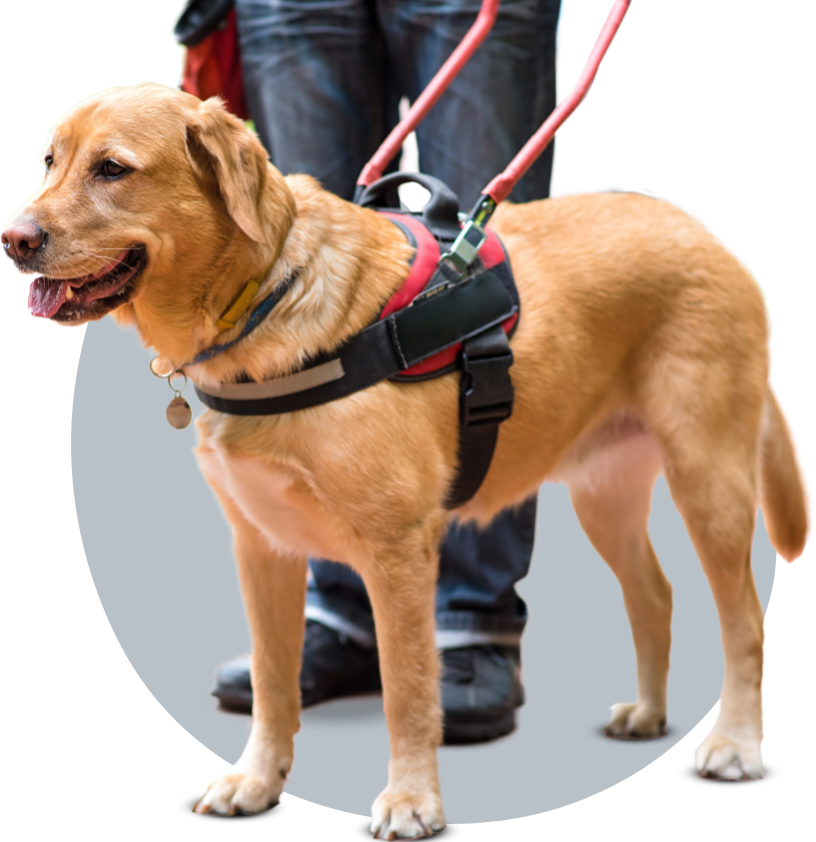Mobility Service Dogs: Your Partner in Independence

Mobility service dogs are more than just pets; they are lifelines for individuals with disabilities, offering them a chance at a more independent and manageable life. In this guide, we delve deep into the world of mobility service dogs, from defining their roles to selecting the ideal breeds, training methodologies, and maintenance training tips. Whether you’re considering getting a mobility service dog or training one independently, this guide is your go-to resource.
What is a Mobility Service Dog?
Mobility service dogs are specially trained canines that assist individuals with mobility impairments. Unlike regular pets, these dogs undergo extensive training to perform tasks that mitigate the challenges faced by their handlers. From pulling wheelchairs to providing balance support and retrieving items, these dogs are equipped to handle various needs, ensuring their handlers’ safety and independence.
Ideal Breeds for Mobility Service Dogs
Temperament Matters
When selecting a breed for mobility tasks, temperament is as crucial as physical attributes. Ideal candidates exhibit calmness, intelligence, and a willingness to learn. They should be neither overly aggressive nor too timid, displaying a balance that makes them reliable in various situations.
Physical Attributes
Large breeds are often preferred for mobility assistance due to their strength and size, which are essential for tasks like pulling a wheelchair and providing balance support. However, the breed should also be agile and healthy, with a predisposition for few hereditary health issues.
Top Picks
- Labrador Retrievers: Known for their friendly nature and intelligence.
- Golden Retrievers: Cherished for their patience and eagerness to please.
- Standard Poodles: Valued for their hypoallergenic coats and sharp minds.
- Bernese Mountain Dogs: Adored for their strength and gentle demeanor.
Three Methods to Obtain a Mobility Service Dog
1. Trainer/Training Organization
Trainer or training organizations specialize in breeding, raising, and training service dogs for various purposes, including mobility assistance. These organizations employ professional trainers who utilize structured programs to train dogs to perform specific tasks tailored to individual needs. The process typically involves an application and assessment process to match handlers with suitable dogs. Once matched, the dog undergoes intensive training, often lasting several months, to ensure proficiency in mobility tasks. While this method may involve a waiting period and financial investment, it offers the assurance of working with experienced professionals who understand the intricacies of training service dogs.
Assistance Dog International (ADI) is a great resource to locate an ADI credentialed trainer in your area that may be able to assist you with having your dog trained to become a mobility service dog.
2. Non-profit Organizations
Non-profit organizations dedicated to providing assistance dogs often offer mobility service dogs as part of their programs. These organizations rely on donations and fundraising efforts to cover the costs associated with breeding, training, and placing service dogs. Individuals seeking a mobility service dog through non-profit organizations may be required to meet certain eligibility criteria and undergo an application and interview process. Once accepted into the program, the individual is matched with a suitable dog and provided with training and ongoing support. This method may offer financial assistance or reduced costs compared to private trainers or organizations, making it accessible to a broader range of individuals.
3. Self-training
Self-training involves individuals taking on the responsibility of training their own mobility service dog. While this method offers the flexibility of training the dog according to the handler’s specific needs and preferences, it requires a significant commitment of time, resources, and knowledge. Self-training typically involves researching training methodologies, attending obedience classes, and working closely with the dog to teach desired tasks. Positive reinforcement techniques, such as clicker training, are commonly utilized in self-training programs. While self-training can be a rewarding experience, it requires dedication and consistency to ensure the dog develops the necessary skills to assist with mobility tasks effectively.
Each method of obtaining a mobility service dog has its own advantages and considerations. Individuals should carefully evaluate their options based on factors such as cost, time, and level of support needed. Ultimately, the goal is to find a method that best suits the individual’s needs and circumstances, ensuring a successful partnership between handler and dog.
How to Train Your Own Mobility Service Dog
Positive Reinforcement
Positive reinforcement involves rewarding desired behaviors, which encourages the dog to repeat them. Rewards can be treats, praise, or anything the dog finds satisfying.
Clicker Training
Clicker training is a form of positive reinforcement where a clicker is used to mark the exact moment a dog performs the correct behavior, followed by a reward. It’s highly effective for teaching complex tasks.

Step-by-Step Guide for Key Tasks
Pulling a Wheelchair
- Acclimation: Familiarize the dog with the wheelchair by allowing it to explore and sniff it without movement.
- Harness Training: Introduce a specially designed harness that distributes weight evenly.
- Command Introduction: Start with simple commands like “pull” in a distraction-free environment.
- Gradual Progression: Slowly increase the duration and complexity of the task, ensuring the dog is comfortable and confident.
Providing Balance Support
- Strength Training: Incorporate exercises that enhance the dog’s core and leg strength.
- Harness and Support Gear: Use a harness that provides stability for both the dog and the handler.
- Balance Commands: Teach commands such as “brace” in controlled environments before gradually moving to real-life scenarios.
Retrieving Items
- Item Familiarization: Introduce the items to be retrieved, allowing the dog to sniff and interact with them.
- Fetch and Give: Start with basic fetch games, progressing to specific item retrieval using names for each item.
- Realistic Practice: Practice in real-life scenarios, gradually increasing complexity and distance.
Troubleshooting Training Challenges
- Consistency is Key: Maintain a consistent training schedule and command usage.
- Patience Pays Off: Some dogs may learn slower than others. Patience and persistent positive reinforcement are crucial.
- Adaptability: Be ready to adjust your training approach based on the dog’s learning style and progress
Socializing and Public Acclimation
Ensuring your mobility service dog is well-socialized and comfortable in public spaces is vital. This includes regular exposure to different environments, noises, and people. Reward calm and appropriate behavior to reinforce confidence in various settings.
Selecting the Right Dog
Choosing a dog for mobility assistance should be done with care, considering the dog’s temperament, size, breed characteristics, and your personal needs. Professional assistance in selecting and evaluating a potential service dog can be invaluable.
Maintenance Training
To ensure the dog remains proficient in its tasks, regular maintenance training is necessary. This includes revisiting basic commands, practicing tasks in different settings, and ensuring the dog’s skills are sharp and reliable.
Registering Your Mobility Service Dog with National Service Animal Registry
Registering your mobility service dog with National Service Animal Registry (NSAR) offers numerous benefits to both you and your canine partner. NSAR provides a simple and free registration process that helps establish your dog’s status as a service animal, which can facilitate smoother access to public places and accommodations. Here’s why registering with NSAR is advantageous:
- Legitimacy: Registration with NSAR adds legitimacy to your mobility service dog’s status. With a registered service dog, you can confidently assert your rights under the Americans with Disabilities Act (ADA) when accessing public spaces, transportation, housing, and other areas where service animals are allowed.
- Identification: NSAR provides identification tools such as vests, ID cards, and other merchandise that clearly indicate your dog’s role as a service animal. These visual cues not only help others recognize your dog’s purpose but also signal your commitment to responsible ownership.
- Ease of Access: Having your mobility service dog registered with NSAR can streamline interactions with businesses, landlords, and transportation providers. Showing your registration documentation and identification products can help mitigate misunderstandings and ensure smoother access to the accommodations and services you need.
- Peace of Mind: Registering with NSAR offers peace of mind, knowing that you have official documentation and support to navigate situations where your service dog’s presence may be questioned. It provides a sense of security and empowerment as you go about your daily activities with your trusted companion by your side.
NSAR offers a range of registration options, including free basic registration and premium packages with additional benefits. Take advantage of NSAR’s services to register your mobility service dog today and enjoy the confidence and convenience that come with official recognition and identification.
Conclusion
Mobility service dogs offer invaluable assistance, but finding and training the right dog requires knowledge, patience, and dedication. By understanding the ideal breeds, training methodologies, and maintenance practices, you can embark on this rewarding journey with confidence. Whether you’re training a dog independently or seeking one trained professionally, remember that the bond you form with your mobility service dog is the foundation of a successful partnership.
Brought to you by National Service Animal Registry. Learn more about us and how to qualify your pet as a service dog, emotional support animal (ESA), or therapy animal, TODAY!













































































